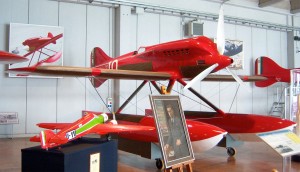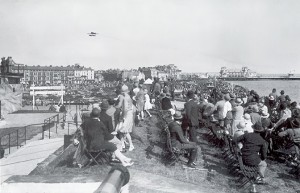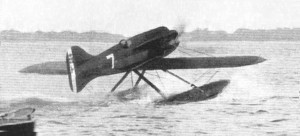
Published on July 10, 2012
On this day in aviation history in 1929, Italy’s entry into the Schneider Cup seaplane races, the Macchi M.67, made its first flight. With the Schneider Cup competition scheduled for the first week of September, the Macchi team and Italy’s pilots had to rush through test flying at Lake Garda in northern Italy. The Macchi M.67, however, proved to be more problematic than its predecessors, the M.39 and M.52.
The new 18-cylinder, 1,798 hp Isotta-Fraschini Asso 1000 “Ace” W-18 engine proved completely unreliable. While 27 engines were manufactured to support the team through testing and the race, already that number had been reduced when several exploded during bench tests. The M.67 design, however, was the best that Italy had to offer, so the preparations continued. A three-bladed prop was fitted to translate the engine’s raw power into speed. This also produced a huge amount of torque, which made taking off in the little red M.67 a challenge.
Disaster at Lake Garda
During a high speed test run in the hands of Captain Giuseppe Motta, the M.67 reached a record-setting speed of 583 kilometers per hour (362 miles per hour). The plane and pilot had been performing perfectly — and then suddenly the plane nosed over and unexpectedly dove straight into the water at high speed. Motta was killed on impact.
It was clear that the team would not be ready for the upcoming race. Therefore, they made a formal request to the British to postpone the race date to give them time to fix the engine and the plane’s aerodynamic problems. The British Royal Aero Club summarily rejected the proposal, perhaps hoping that the Italians would be a no-show, in which case their Supermarine S.6 would fly unopposed. Instead, the Italians viewed it unsportsmanlike to cancel. The team shipped out to Calshot Spit, near Southampton on England’s southern coast, with the two remaining M.67s and a veteran M.52R from the previous race.

The Schneider Cup Race of 1929
At Calshot Spit, the British entries from Supermarine were resplendent in their silver and blue. Italy’s Macchis were painted in bright red, the corso rosso from Italy’s grand racing tradition. Everyone recognized that the M.67 aircraft was a match for the next generation of British racer, the Supermarine S.6, with its 1,900 hp Rolls-Royce R engine — but only if the plane and engine would somehow hold together to complete the three laps necessary at high speed.
Unlike automotive races or sailing regattas, the Schneider Cup was simply a time-trial. Aircraft did not race against one another head-to-head, but rather would take off on a schedule with a gap between flights. This allowed each aircraft to do several high speed laps for timing purposes — a speed run for the 1929 races involved three laps at low altitudes around a course marked out by pylons on the water. The speeds would be computed based on the times recorded from start to finish.
Italy’s first flight would be an M.67 flown by Lieutenant Remo Cadringher. He made an impressive pass at the start his run, coming past the start point at incredible speed. Then, as he entered the first turn, the Asso 1000 engine began to come apart. In the cockpit, Cadringher suddenly found himself engulfed in choking smoke and fumes. Unable to see, he lost control of the M.67 as it entered the first turn — the plane skidded off line and headed over the land, where it snapped into a spin. Somehow, despite the weight of the floats and the M.67?s small control surfaces, Cadringher broke the stall and recovered from the spin. Nobody would have thought it wrong if he had circled back for an emergency landing, yet Cadringher made another try. The engine continued to thunder on, spewing black smoke. Somehow, Cadringher would complete the series of three laps despite being unable to see the pylons through the smoke that filled the cockpit. He set a speed of 457 kilometers per hour (284 mph) and then came in for a landing.

Lieutenant Giovanni Monti next would take the second M.67 up to represent the Italian side. The courage he showed in climbing into the cockpit was extraordinary, given the problems that the team was experiencing. Monti took off in the second of the two M.67s and began his speed laps. Everything held together as he paced around to set an average time of 485.5 kilometers per hour (301.7 mph) — finally a number for the British to beat. Still, the speeds were well shy of the standing record of 583 kilometers per hour (362 miles per hour) that had been achieved in the M.67 before it had killed his teammate Motta at Lake Garda a month earlier. Monti pressed forward for another speed run, hoping to improve the speed. Once again, disaster struck. The radiator exploded and shower Monti with scalding hot water and steam. Badly injured and in extreme pain, he managed an emergency landing. He was taken immediately to the hospital.
Finally, the older Macchi M.52R made its run, tallying up a speed sufficient to take second place in the races. As expected, a British Supermarine S.6 took the trophy with a race speed of 528.88 kilometers per hour (328.63 mph). The S.6 had clocked in considerably slower than Motta’s record speed in the M.67, which showed just what the Italians might have been capable of achieving if the engine and aerodynamic problems had been resolved. A celebratory dinner would follow with an awards ceremony. The Schneider Cup may have been lost, but Italy’s national pride remained untarnished, thanks to the courage of their aviators.
One More Bit of Aviation Trivia
England would go on to win the next race at Calshot Spit in 1931 flying its Supermarine S.6Bs. Yet again, Italy’s race team would be plagued with engine and control problems with its latest entry, the Macchi M.C.72. This latest design was revolutionary and featured two engines, one behind the other to minimize profile drag. Each of the two engines would drive one of the two counter-rotating propellers, thus solving the torque problem. For Italy, engine reliability remained a serious issue and it would keep them from attending the race. Britain would compete alone in 1931. Thus, the British had won their third straight Schneider Cup, ending the races and keeping the trophy in Britain for all time to come. Afterward, the Italians pressed on with the development of the M.C.72. Finally, on October 23, 1934, the plane would set a record pace of 709 kilometers per hour (440 mph). That record stands even today nearly 80 years later as the fastest speed ever attained by a propeller-driven seaplane, true testimony to the amazing engineering talent of Italy’s design team and its chief speed designer, Mario Castoldi.
